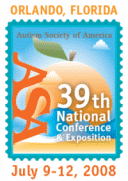 |
The ASA's 39th National Conference on Autism Spectrum Disorders of ASAThe Westin Kierland Resort & Spa, Scottsdale, AZ |
| For a complete author index with session numbers, please click here | |
| Friday, July 11, 2008: 1:45 PM-3:00 PM | |||
| Sanibel 3 | |||
| #3643- Creating Supportive Environments | |||
| Physical structure, routines, schedules, and environmental supports are essential elements in regulating anxiety for individuals with ASD. This session will provide an overview of how to utilize these elements to structure the environment in order to compensate for internal disorganization often experienced. The session will also include video footage of students utilizing environmental supports in a variety of settings. Participants will receive practical information that they can take back to their own settings and use with individuals of all ages. | |||
| Presenters: | - Krista James is currently working to train multidisciplinary teams, serving students with ASD, in districts across Louisiana. She is, most importantly, a Special Education Teacher who has taught students with autism in several states and in a variety of instructional settings ranging from special schools to co-teaching in inclusive classrooms.
- Patty Alewyne is currently working with students with ASD and their multidisciplinary building level teams in Louisiana schools. She is a special education teacher with 15 years experience teaching students with varying mild and significant disabilities in both self contained classrooms and as an inclusion teacher. | ||
|
| |||
|
The premise of this presentation is that many individuals with Autism Spectrum Disorders often experience an internal disorganization that increases their anxiety and inhibits their ability to be prepared to learn. By structuring the external environment, we can make up for this internal disorganization and decrease the anxiety the student is feeling. Participants will learn to structure the external environment by examining five key areas. These areas are: 1. Modifying Physical Structure When we think about modifying the physical structure of the environment, we need to remember the individual needs of the students. We will discuss safety, eliminating visual clutter, organizing materials, using visual boundaries, independent work systems, and creating areas for activities. Participants will receive examples of floor plans for Regular and Special Education classrooms, view examples of classrooms utilizing concepts of physical structure, and see video footage of students working in an environment with clear physical structure. 2. Adapting Environment for Sensory Disorders We know that when students are dysregulated, they are not ready to learn. We will discuss adapting the environment to help with sensory disorders, from a teacher’s perspective. We will explain the role of the Occupational Therapist on the multidisciplinary team. We will stress the importance of working closely with our Occupational Therapists to help our students not only become regulated, but also to help them be able to self-regulate. Participants will learn how sensory processing disorder feels to the individuals experiencing it and will view various adaptations to the environment to help students stay regulated. 3. Establishing Predictable Routines All classrooms need predictable routines in order to function successfully. This is especially true for classrooms with students with ASD. On our quest to eliminate down time, we will discuss the concept of structured down time for our students. We will also discuss the importance of establishing clear routines for the adults in the classroom as well as the students. Participants will view examples of schedules for the adults in the classroom as well as a variety of schedules to use with students with ASD. Participants will view video footage of students in Louisiana classrooms learning to utilize a schedule and, ultimately, utilizing it independently. We will also discuss utilizing a schedule checklist, from the University of North Carolina’s TEACCH program, to design a schedule that will be meaningful to the student. 4. Utilizing Visual Supports We know that visual supports are important, because, many students with ASD have difficulties attending to and processing auditory input. We also know that visual supports are only valuable if the student can derive meaning from them. We will discuss the importance of determining which types of supports will be meaningful to our students and constructing them in a way that the student will understand. Participants will see examples of a variety of visual supports, including: visual schedules, calendars, choice boards, menus, universal “No”, people locators, task organizers, and visual rules. They will also see video footage of students utilizing some of these supports. 5. Supporting Transitions Transitions are often difficult for students and teachers, with or without ASD. We will discuss the importance of supporting transitions in order to decrease anxiety and promote independence. Participants will learn to show transitions on a schedule, refer to a clock, set a timer, provide a natural ending, and use transition objects or transition helpers to support students and increase independence. Participants will view video footage of teachers and students utilizing these concepts in their classrooms. At the end of this presentation, participants will be equipped with a practical “bag of tricks” to use in their home, school, and community environments. We will stress the importance of promoting independence and decreasing prompt dependency in order to best serve individuals with ASD. We will also teach participants the importance of making the materials age appropriate and individual to the student. |
|||
See more of General Submissions
See more of The ASA's 39th National Conference on Autism Spectrum Disorders